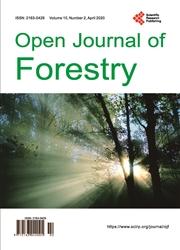Using Water Stable Isotopes to Trace Water Sources of Three Typical Japanese Tree Species under Heavy Rainfall Conditions
引用次数: 2
Abstract
Stable isotopes of xylem water (18O and D) have been successfully used to determine sources of soil water for plant transpiration, but mainly in drought-prone environments. The water uptake strategies of three representative tree species in Japan, namely cedar (Cryptomeria japonica), larch (Larix kaempferi) and beech (Fagus crenata), were investigated using δ18O and δD of water (precipitation, soil and xylem), together with wood α-cellulose δ13C and δ18O, along one growing season. The study was carried out in the research forest of Yamagata University (Shonai region), a high precipitation area in Japan, which exceeds 3000 mm per year. Precipitation water δ18O and δD increased along the summer growing season, but oxygen and hydrogen isotopic composition of soil water remained essentially unchanged. In general, xylem water isotopes of cedar and larch followed the local meteoric water line, but beech xylem water was decoupled from soil and precipitation values in July and August. For this tree species, the xylem water isotopic records were more depleted than cedar and larch xylem water isotopic values and the precipitation water isotopic records, indicating that beech used more water from soil layers during July-August than the other two species, which mainly used newly-fallen precipitation. Wood δ18O showed an opposite seasonal trend to the one found for xylem water, likely because of leaf water isotope enrichment, which was in turn controlled by seasonal transpiration rate. The higher δ13C values of cedar during summer suggested that this species had enhanced water-use efficiency during the growing season compared with the deciduous species larch and beech. Our results highlight different water use strategies among forest tree species even in areas where the annual water balance is far from limiting plant performance.利用水稳定同位素追踪强降雨条件下日本三种典型树种的水源
木质部水分的稳定同位素(18O和D)已经成功地用于确定植物蒸腾的土壤水分来源,但主要是在干旱易发环境中。利用水分(降水、土壤和木质部)δ18O和δD,以及木材α-纤维素δ13C和δ18O,研究了日本3种代表性树种杉木(Cryptomeria japonica)、落叶松(Larix kaempferi)和山毛榉(Fagus crenata)在一个生长季节的吸水策略。该研究是在山形大学的研究林(正内地区)进行的,这是日本每年超过3000毫米的高降水量地区。降水水δ18O和δD随夏季生长季增加,但土壤水氧和氢同位素组成基本保持不变。7月和8月,杉木和落叶松木质部水分同位素总体上遵循当地大气水线,而山毛榉木质部水分与土壤和降水值不耦合。该树种木质部水分同位素记录比杉木和落叶松的木质部水分同位素和降水水分同位素记录耗损更大,说明7 ~ 8月山毛榉利用了更多的土层水分,主要利用了新降水。木材δ18O的季节变化趋势与木质部水分δ18O的季节变化趋势相反,这可能是由于叶片水分同位素富集,而叶片水分同位素富集又受季节蒸腾速率控制。夏季雪松的δ13C值较高,表明其生长季水分利用效率高于落叶松和山毛榉。我们的研究结果强调了即使在年水平衡远未限制植物性能的地区,森林树种之间也存在不同的水分利用策略。
本文章由计算机程序翻译,如有差异,请以英文原文为准。
求助全文
约1分钟内获得全文
求助全文

 求助内容:
求助内容: 应助结果提醒方式:
应助结果提醒方式:


